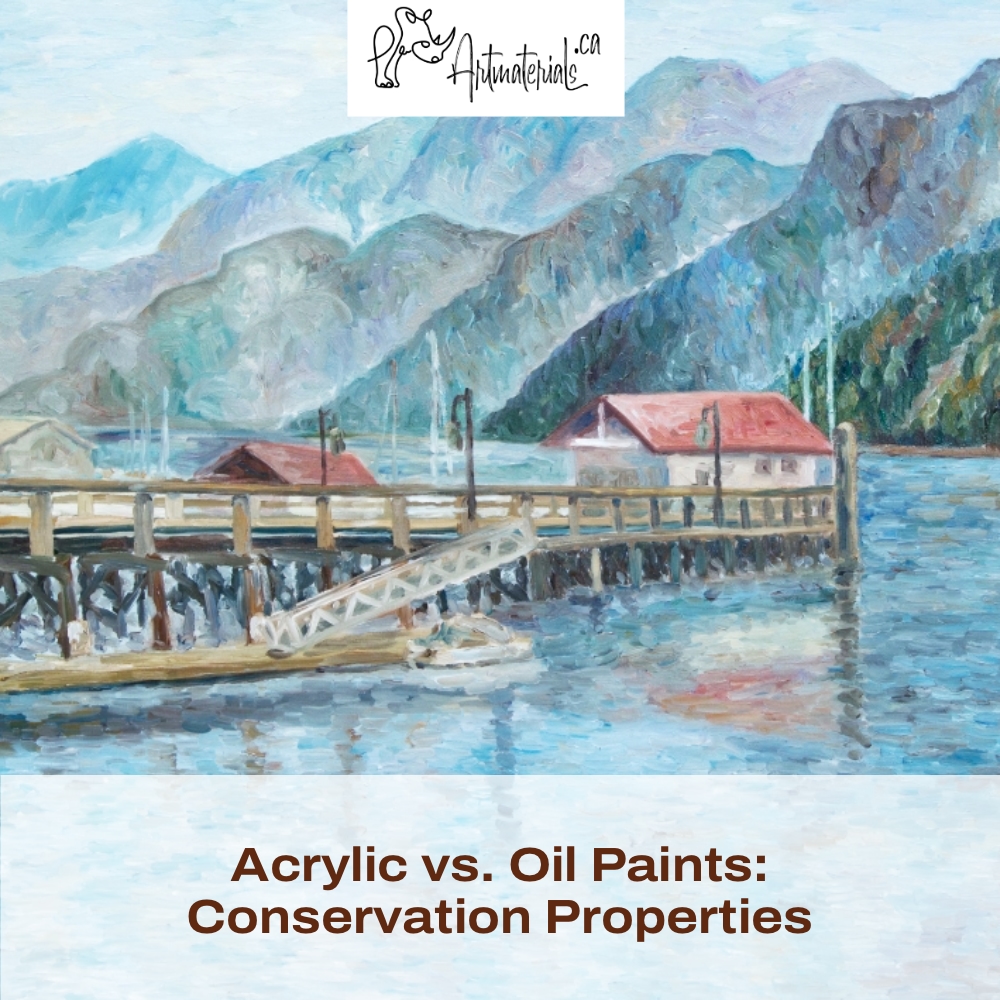Many artists dream about having their work exhibited in museums that would preserve art for generations. Even if your painting is not going to get there the question about the archival properties of your work is still important. Some art can show signs of deterioration, such as:
1. Fading or discoloration. Over time, exposure to light and environmental factors can cause colours to fade or change. This is particularly noticeable in artworks created with pigments with poor lightfastness.
2. Cracking or flaking. Paintings, especially those done on canvas, may develop cracks or flakes due to aging, changes in humidity, or improper handling/storage. This can result in the loss of paint layers or sections of the artwork.
3. Yellowing or darkening of varnish. Varnish applied to protect and enhance the appearance of a painting can yellow or darken over time, altering the original colours and clarity of the artwork.
4. Mold or mildew growth.
5. Loss of adhesion. In some cases, the layers of paint or other materials may detach or lose adhesion to the support, leading to flaking or detachment of sections of the artwork.
Let’s take a look at these aspects of oil and acrylic paintings.
 Fading or discolouration
Fading or discolouration
In oil, it can come from two aspects: wrong pigment use or wrong conditions of paint application. If we compare oil to acrylic, pigment use will be about the same. As both refer to opaque mediums, pigments are supposed to have similar lightfastness at use. However, oil drying processes are much more complex and longer than for acrylics, so fading can occur if drying is happening at lower temperatures and unstable or high humidity.
For acrylics, during the water evaporation process, discolouration may be noticeable much faster. It’s not an actual colour loss, but rather the effect of wet colour vs. dry colour (similar to a wet and dry rock). Also, generally speaking, professional oil paints have a higher pigment load in the tube than acrylics and fewer fillers and thickeners that help keep colour almost unchanged from application to the end of the visible drying process (provided that storage conditions are met). Excessive fillers may make paints “milky” and less vibrant after full drying, especially in acrylics.
 Cracking or flaking
Cracking or flaking
Oil paints, generally speaking, potentially develop more cracking than acrylics. Especially, if an artist didn’t follow the “fat over lean” rule. Fat over lean refers to the principle in oil painting of applying paint with a higher oil-to-pigment ratio (‘fat’) over paint with a lower oil-to-pigment ratio (‘lean’) to ensure that the film is flexible and durable.
The Canadian Conservation Institute (CCI) points out that oil paintings are particularly vulnerable to low relative humidity (RH) conditions, which are very common indoors during Canadian winters.
In low RH conditions, the size, ground and paint layers become more brittle and higher stress within the layers can develop. Below 35% RH, they are more likely to develop cracks, which in turn can lead to lifting paint and paint loss. Also, RH fluctuation of more than 10% can contribute to cracking, especially for impasto paintings. In other words, storage conditions are very important to prolong an oil painting’s life.
What about acrylic paint, there is currently extensive research being undertaken to increase our understanding of the composition and properties of modern paints. Even though acrylic paints form a more flexible film than oil paints and seem less prone to cracking, we don’t have statistical data enough to determine if similar defects develop with natural aging.
What we know is that acrylic paint becomes more vulnerable to cracking at moderately low temperatures. It increases dramatically in stiffness at temperatures of +5 …10 °C, which is not too low considering Canadian winters. The potential for cracking at these temperatures makes handling and transporting paintings questionable in Canadian winter conditions.
 Yellowing or darkening of varnish
Yellowing or darkening of varnish
Usually, this is attributed to oil paintings, especially quite old ones. To protect the painting surface, we use damar varnish that tends to yellow and darken with time as it absorbs dust and some humidity from the environment. The good news is that it’s fixable. There are tons of successful restoration works performed over time when the old varnish was cleaned or/and re-applied. Painting layers themselves were not affected.
Even though acrylic varnish doesn’t yellow with time, it doesn’t provide proper protection for the artwork. According to CCI, acrylic paints tend to attract and absorb dirt at ambient or high temperatures making it impossible to clean the surface of acrylic painting without affecting and damaging the paying layer. Because of these, the CCI suggests protecting acrylic paintings with glass.
Mold or mildew growth
High humidity or improper storage conditions can lead to the growth of mould or mildew on artworks, particularly on wood or canvas materials. Both acrylic and oil paintings may be affected by this equally.
 Loss of adhesion
Loss of adhesion
Here, we should go deep inside the polymerization process. In chemistry, monomers are molecules that can react with each other to form a larger polymer chain or three-dimensional network. This process is called polymerization and it goes differently for acrylic and oils.
Oil creates a durable bond with most of the surfaces, including metals, forming a flexible film. If the surface is porous, the bond will be even stronger. Acrylic polymerization takes place within itself and the only thing that holds the paint is its penetration to a porous surface normally provided by acrylic primer. That explains why acrylic paints are so easy to peel off from your plastic, glass, or even wooden palette. And, of course, the same thing may happen to your painting.
















os September 26, 2023 at 8:40 pm
excellent post. thank you!
Elena Nahum Leroy September 26, 2023 at 8:45 pm
Thank you for your appreciation!